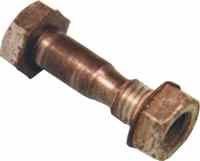Presented below is a case history of a torque tightening problem experienced
by a vehicle manufacturer.

The Problem
A manufacturer was experiencing problems with the fasteners securing a bracket
supporting part of a rear suspension on a vehicle. There were two problems:
1. On some, but not all vehicles, the bracket was slipping resulting in
fretting. The relative movement which was occurring between the bracket and
the bolts was causing elongation of the bracket's holes and necking of the
shanks of the bolts. This was happening even with the bolts being pre-applied
with thread locking adhesive. Inspection of the bolts on failed units
confirmed that the nuts were not rotating loose. The photo shows one of the
necked bolts.
2. During assembly, on certain batches of bolts, a proportion where failing
on initial torque-up. This was despite a torque wrench being used to ensure
consistency of the torque value.
Background to the Problem
From test and analytical work completed during the initial design of the
assembly, a clamp force from the fasteners of 105 kN was required to prevent
slippage of the bracket from suspension induced loading. The bolts being used
where four M12 strength grade 8.8 zinc plated fasteners. During the design
stage it was realised that the effect of the thread adhesive was to increase
the thread friction. Based upon a thread friction coefficient of 0.2 and an
underhead friction coefficient of 0.14, a preload of 34 kN was calculated
together with a tightening torque of 90 N-m. With four bolts being used, the
clamp force of 136 kN was considered more than adequate for the application.
Due to the failures, the adequacy of the design of the assembly was
re-assessed. Based upon this investigation it was revealed that:
1. The thread friction coefficient could vary
between 0.14 and 0.25.
2. The underhead friction coefficient could vary
between 0.10 and 0.18.
3. A prevailing torque of 7 N-m resulted from the frictional drag
associated with the thread locking adhesive.
The Cause of the Problem
It was realised by the engineers that the problems they had been experiencing
was as a result of frictional scatter not being accounted for at the design
stage. Based on a torque wrench accuracy of 5%, 85.5 N-m would be the lowest
value of torque applied to each of the bolts. Using this tightening torque
with the highest values of friction and a prevailing torque of 7 N-m, they
determined that the bolts clamp force would only be 23.9 kN, under the worst
case condition. This was significantly below that which the application
required.
The Solution
To overcome the two problems the company's engineers re-assessed the basis
on-which they determined the bolts tightening torque and the resulting clamp
force. Briefly; they deduced that a higher strength grade of bolt was
required. It was decided to use M12 strength grade 10.9 bolts, flange headed
to provide resistance to vibration loosening and ease of re-assembly during
maintenance work. To determine the tightening torque and resulting clamp force
the engineers:
- Determined the tightening torque using the lowest value of friction
coefficients. A torque of 110.5 N-m was determined on this basis utilising
90% of the fastener strength due to the combined effects of tensile and
torsional stresses.
- This torque value was reduced by 5% (to 105 N-m) to allow for torque
wrench inaccuracy. This torque value was to be specified so that even
under adverse conditions, the bolts would not fail on initial torque-up.
- Using the 105 N-m torque value and the highest anticipated friction
coefficients, a clamp force of 30.4 kN was determined. This clamp force is
the minimum value which could be anticipated based upon the worst case
frictional conditions.
The piechart how the 105 N-m tightening torque is distributed within the
fastener. (The chart is from the TORQUE
program.)

Following a test programme, the revised fasteners and torque specification
was introduced as a design change and as a service modification to vehicles in
the field. No further problems were reported.
To assist the Engineer in overcoming the problems associated with the use
of threaded fasteners and bolted joints, Bolt Science has developed a number
of computer programs.
These programs are designed to be easy to use so that an engineer without
detailed knowledge in this field can solve problems related to this subject.
[SureBolt] [ Video ]